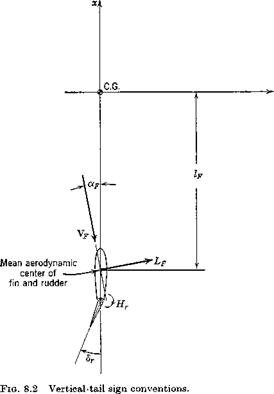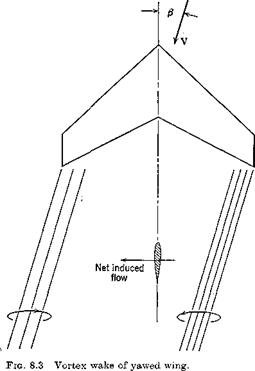YAW STIFFNESS (WEATHERCOCK STABILITY)
By exactly the same argument as used for pitch stiffness (Sec. 6.2), we conclude that flight vehicles should have positive yaw stiffness, i. e. (see Fig. 8.1) dCJdfi > 0. For then a perturbation in /3 will produce a restoring moment N that tends to keep the velocity vector in the plane of symmetry.
|
|
Fna. 8.1 Sideslip angle and yawing moment.
|
|
СПр is found from wind-tunnel measurements of the yawing moment, or when these are not available, can be estimated by synthesising the contributions of the various components of the vehicle. The principal contributions are those of the body and the tail. By contrast with Cm, the wing makes a relatively small contribution to (7n.
In Fig. 8.2 are shown the relevant geometry and the lift force LF acting on the vertical tail surface. If the surface were alone in an airstream, the velocity vector Yf would be that of the free stream, so that (cf. Fig. 8.1) <xF would be equal to —/?. When installed on an airplane, however, changes in both magnitude and direction of the local flow at the tail take place. These changes may be caused by the propellor slipstream, and by the wing and fuselage when the airplane is yawed. The angular deflection is allowed for by introducing the sidewash angle a, analogous to the downwash angle є. a is positive when it corresponds to a flow in the у direction: i. e. when it tends to increase olf. Thus the angle of attack is
*F=~P + o (8.1,1)
and in the linear case the lift coefficient of the vertical-tail surface is
CLr = <*,(-/? + a) + aA (8-1,2)
The lift is then
lf = GLf V2SF (8.1,3)
Just as with the horizontal tail, any difference between VF and V is absorbed into the coefficients aF and ar. The yawing moment is
nf = – cLf£v*sfif
whence C„F = – CLf (8.1,4)
isb
The ratio SFlFjSb is analogous to the horizontal-tail volume ratio, and is therefore called the vertical-tail volume ratio, denoted here by Vv. Equation
(8.1,4) then reads
0„ = – VvCLf (8.1,5)
and the corresponding contribution to the weathercock stability is
|
|
The Sidewash Factor do/df}. Generally speaking the sidewash is difficult to estimate wdth engineering precision. Suitable wind-tunnel tests are required for this purpose. The contribution from the fuselage arises through its behavior as a lifting body when yawed. Associated with the side force that develops is a vortex wake which induces a lateral-flow field at the tail. The sidewash from the propeller is associated with the side force which acts upon it when yawed, and may be estimated by the method of ref. 7.3, previously cited in Sec. 7.3. The contribution from the wing is associated with the asymmetric structure of the flow that develops when the airplane is yawed. This phenomenon is especially pronounced with low-aspect-ratio swept wings. It is illustrated in Fig. 8.3.
The Velocity Ratio VF/V. When the vertical tail is not in a propeller slipstream, VF/V is unity. When it is in a slipstream, the effective velocity increment may be dealt with as for a horizontal tail (see Sec. 7.3).
|
|
Contribution of Propeller Normal Force. The yawing moment produced by the normal force which acts on the yawed propeller is calculated in the same way as the pitching-moment increment dealt with in Sec. 7.3. The result is similar to (7.3,10)
nv __ ^v 30Np /g j
dp b S dap ‘
This is known as the propeller fin effect, and is negative, i. e. destabilizing, when the propeller is forward of the C. G., but is usually positive for pusher propellers.














